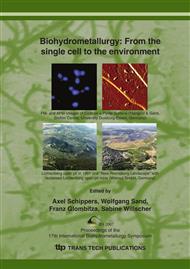[1]
W. Eberhardt: Surf. Sci. Vol. 500 (2002), p.242.
Google Scholar
[2]
H. Hori, T. Teranishi, Y. Nakae, Y. Seino, M. Miyake and S. Yamada: Phys. Lett. A Vol. 263 (1999), p.406.
Google Scholar
[3]
S. Nishimura: Handbook of Heterogeneous Catalytic Hydrogenation for Organic Synthesis (Wiley, New York, Chichester, 2001).
Google Scholar
[4]
C. Schuth and M. Reinhard: Appl. Catalysis B-Environmental Vol. 18 (1998), p.215.
Google Scholar
[5]
P. Mulvaney, L.M. Liz-Marzan, M. Giersig and T. Ung: J. Mater. Chem. Vol. 10 (2000), p.1259.
Google Scholar
[6]
T. Taniyama, T. Sato, E. Ohta and M. Takeda: Physica B Vol. 213 (1995), p.254.
Google Scholar
[7]
T.V. Choudhary and D.W. Goodman: Top. Catal. Vol. 21 (2002), p.25.
Google Scholar
[8]
L.E. Macaskie, P. Yong, M. Paterson-Beedle, A.C. Thackray, P.M. Marquis, R.L. Sammons, K.P. Nott and L.D. Hall: J. Biotechnol. Vol. 118 (2005), p.187.
DOI: 10.1016/j.jbiotec.2005.03.006
Google Scholar
[9]
L.E. Macaskie, R.M. Empson, F. Lin and M.R. Tolley: J. Chem. Technol. Biotechnol. Vol. 63 (1995), p.1.
Google Scholar
[10]
M. Paterson-Beedle, K.P. Nott, L.E. Macaskie and L.D. Hall, in: Microbial Growth in Biofilms, Pt B, edited by R. J. Doyle, (2001), p.285.
Google Scholar
[11]
V.J.M. Allan, M.E. Callow, L.E. Macaskie and M. Paterson-Beedle: Microbiology-SGM Vol. 148 (2002), p.277.
Google Scholar
[12]
J. R. Lloyd, P. Yong and L.E. Macaskie: Appl. Environ. Microbiol. Vol. 64 (1998), p.4607.
Google Scholar
[13]
P. Yong, N.A. Rowson, J.P.G. Farr, I.R. Harris and L.E. Macaskie: Biotechnol. Bioeng. Vol. 80 (2002), p.369.
Google Scholar
[14]
V.S. Baxter-Plant, I.P. Mikheenko and L.E. Macaskie: Biodegradation Vol. 14 (2003), p.83.
Google Scholar
[15]
A.N. Mabbett, P. Yong, J.P.G. Farr and L.E. Macaskie: Biotechnol. Bioeng. Vol. 87 (2004), p.104.
Google Scholar
[16]
A.N. Mabbett, D. Sanyahumbi, P. Yong and L.E. Macaskie: Environ. Sci. Technol. Vol. 40 (2006), p.1015.
Google Scholar
[17]
I. de Vargas, D. Sanyahumbi, M.A. Ashworth, C.M. Hardy and L.E. Macaskie, in: 16th International Biohydrometallurgy Symposium, edited by S. T. L. Harrison, D. E. Rawlings and J. Petersen, 16th International Biohydrometallurgy Symposium, Cape Town, (2005).
DOI: 10.1016/j.hydromet.2006.03.031
Google Scholar
[18]
I.P. Mikheenko, P.M. Mikheenko, S. Dementin, M. Rousset and L.E. Macaskie, in: 16th International Biohydrometallurgy Symposium, edited by S. T. L. Harrison, D. E. Rawlings and J. Petersen, Cape Town, (2005), p.383.
Google Scholar
[19]
S. Selenska-Pobell, P. Panak, V. Miteva, I. Boudakov, G. Bernhard and H. Nitsche: FEMS Microbiol. Ecol. Vol. 29 (1999), p.59.
DOI: 10.1111/j.1574-6941.1999.tb00598.x
Google Scholar
[20]
J. Wood and P.H. Turner: Appl. Spectrosc. Vol. 57 (2003), p.293.
Google Scholar
[21]
I. P. Mikheenko, Ph. D. Thesis, (2004).
Google Scholar
[22]
N.J. Creamer, I.P. Mikheenko, P. Yong, K. Deplanche, D. Sanyahumbi, J. Wood, K. Pollmann, M. Merroun, S. Selenska-Pobell and L.E. Macaskie: submitted to Catalysis Today.
DOI: 10.1016/j.cattod.2007.04.014
Google Scholar
[23]
I.P. Mikheenko, K. Deplanche, P. Yong, N.J. Creamer, J. Wood and L.E. Macaskie: submitted to Environmental Microbiology.
Google Scholar
[24]
K. Fahmy, M. Merroun, K. Pollmann, J. Raff, O. Savchuk, C. Hennig and S. Selenska-Pobell: Biophys. J. Vol. 91 (2006), p.996.
DOI: 10.1529/biophysj.105.079137
Google Scholar


